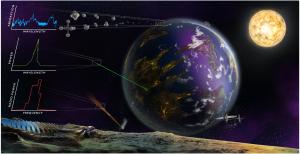Blog
Our Quiet Neighborhood
9 August 2023
 Haqq-Misra, et al
Haqq-Misra, et alThere are perhaps 10,000 stars within 100 parsecs of Earth. Nearly all main-sequence stars have a planetary system, and most have at least one potentially habitable world. There could be thousands of alien civilizations within a spherical chunk of the Milky Way just 650 light-years across. That is, of course, if we take the most optimistic view. It’s also possible that life is so miraculously rare Earth is the only living world in our galactic neighborhood. We could be very, very alone, and a new study suggests that’s the case.1
The study gathered observations from the Green Bank Telescope (GBT) in what is known as the L-band, which has a wavelength of 15 - 30 centimeters. It’s a particularly useful band when looking for alien signals because it’s an easy wavelength to generate artificially. We use it for everything from mobile phones to GPS to radio broadcasts. If there are aliens out there, they likely use this wavelength range.
Green Bank can’t see the entire sky, and it would take far too long to carefully examine the whole sky it can observe, so the team took a statistical sample of various patches of sky.2 They looked at 62 TESS Objects of Interest, which are nearby stars with exoplanets as identified by the Transiting Exoplanet Survey Satellite (TESS). Since the GBT has about a 9 arcminute field of view, this meant the team also captured signals from stars visibly close to the 62 star systems. In all, the team was able to look for signals from nearly 12,000 stars. Some were within 100 parsecs of Earth, but many were more distant.
They found no evidence of an alien technosignal.
Just to make sure they weren’t overlooking technosignals, the team also added fake signals to their data. They were able to see those, meaning that they could distinguish artificial signals from natural ones and background noise. The problem wasn’t detecting alien broadcasts, the problem was they weren’t there. Statistically, that means there’s about a 98% chance that of the thousands of stars within 100 parsecs of Earth, no more than one of them has an alien technosignal.
Statistics is a fickle beast. We might get lucky, and there are 2 or 3 neighboring civilizations. If so, we will likely discover them in time. But there could also be zero. We may be the only civilization in our spiral arm or even the entire galaxy. At this point, we don’t really know.
But we do know now that intelligent life is at least somewhat rare in the universe. Human civilization is a cosmically rare treasure. As we struggle on this small rock of ours, we would do well to remember that.
Margot, Jean-Luc, et al. “A Search for Technosignatures Around 11,680 Stars with the Green Bank Telescope at 1.15-1.73 GHz” arXiv preprint arXiv:2308.02712 (2023). ↩︎
Haqq-Misra, Jacob, et al. “Searching for technosignatures in exoplanetary systems with current and future missions.” Acta Astronautica 198 (2022): 194-207. ↩︎